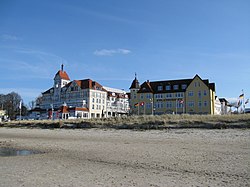Kühlungsborn
| Kühlungsborn | ||
|---|---|---|

Spa buildings at the beach showing local resort architecture
|
||
|
||
| Coordinates: 54°08′N 11°45′E / 54.133°N 11.750°ECoordinates: 54°08′N 11°45′E / 54.133°N 11.750°E | ||
| Country | Germany | |
| State | Mecklenburg-Vorpommern | |
| District | ||
| Government | ||
| • Mayor | Rainer Karl (CDU) | |
| Area | ||
| • Total | 16.16 km2 (6.24 sq mi) | |
| Elevation | 10 m (30 ft) | |
| Population (2015-12-31) | ||
| • Total | 7,824 | |
| • Density | 480/km2 (1,300/sq mi) | |
| Time zone | CET/CEST (UTC+1/+2) | |
| Postal codes | 18225 | |
| Dialling codes | 038293 | |
| Vehicle registration | LRO | |
| Website | www.stadt-kuehlungsborn.de | |
Kühlungsborn (German pronunciation: [ˈkyːlʊŋsbɔʁn]) is a Seebad (seaside resort) town in the district, in Mecklenburg-Vorpommern, Germany. It is situated on the Baltic Sea coast, 11 km northwest of Bad Doberan, and 25 km northwest of .
The town has an elongate beach and promenade, many hotels in typical German spa town architecture and a marina. It is the largest seaside spa town in Mecklenburg.
Kühlungsborn is a place with long spa traditions. It was one of the first seaside resorts to be founded in Germany, dating back to the 1860s. While the bicycle is a popular way of transport, the Molli steam railway is an historic tourist attraction that also allows exploration the area. In summer times many people rent one of the traditional Strandkorb on the beach, a covered chair protecting one from wind and sun.
The town of Kühlungsborn was founded on April 1, 1938 with the merger of the three municipalities; Fulgen, Brunshaupten and Arendsee. On the town coat of arms, three flying seagulls on a blue background represent these former municipalities.
At the end of World War II in 1945, many refugees settled temporarily or permanently in Kühlungsborn. In 1953, the East German government partially expropriated and arbitrarily nationalised a number of hotels and boarding houses in the city during the so-called "Action Rose". Over 50 of these institutions were transformed into holiday and health resorts for regulated holidays for East German citizens which were controlled by FDGB Trade Union. If the former owners resisted, they were often convicted in show trials. Many were forced into exile in West Germany.
During East Germany's standard holiday period of July to August, Kühlungsborn was packed with holidaymakers. The cost of the FDGB holiday facilities was very low, normally 60-100 East German marks for 14 days full board. During this time there were frequent shortages in commercial establishments. Annual festivals were conducted for three decades, during "Baltic Week", usually the first week of July. There were numerous high-profile cultural events during these festivals. Participants from the Baltic Sea countries and Norway were accommodated in boarding houses.
...
Wikipedia



